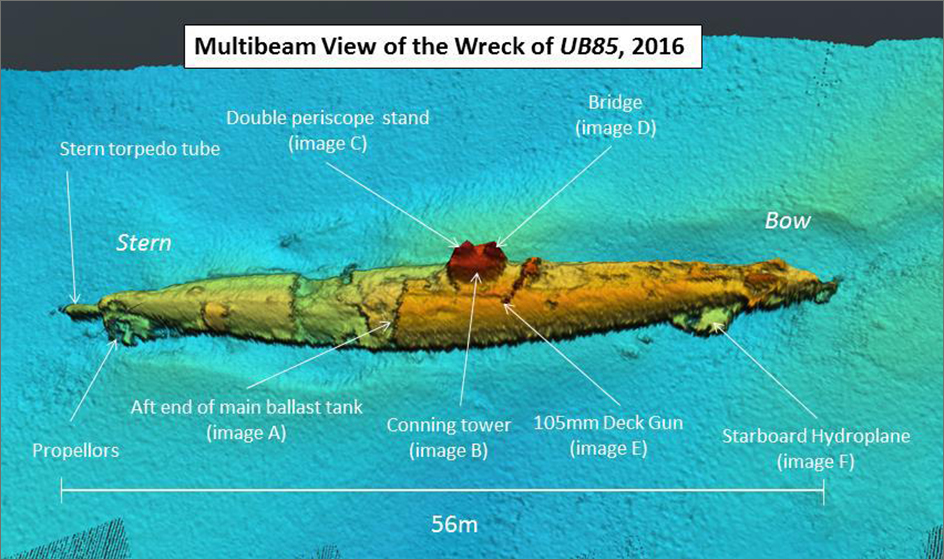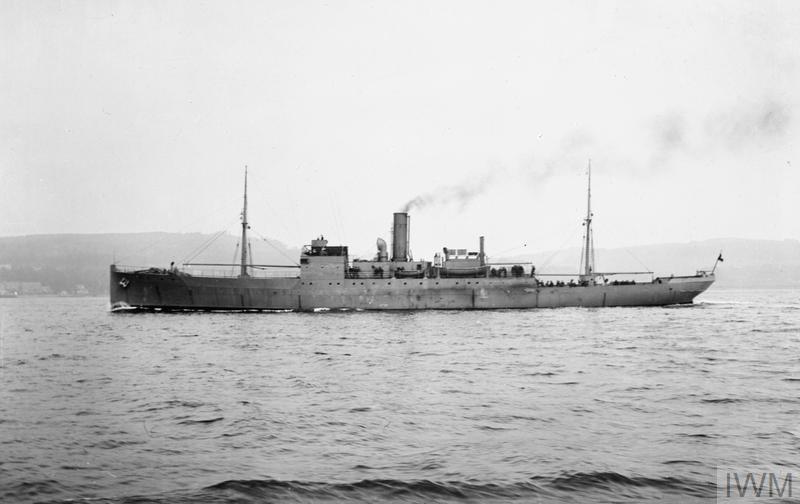October
WW I U-boat Wreck discovered off the Galloway Coast
During work for the underwater power line “Western Link” marine engineers have discovered the wreck of a German U-boat from WW I in the Irish Sea. The electricity highway Western Link, which is still under construction is designed to transmit renewable energy from Scotland via the Irish Sea to Wales. In total it is 262 mi long with 239 mi underwater. It is expected to cost 1,1 Billion Euros and is the first 600 kV direct current subsea power link.

During survey work for Western Link between Scotland and Northern Ireland the wreck was discovered approximately 30 mi NW of Stranraer in a depth of 104 m. Scottish Power made multi beam sonar scans of the wreck and presented these to Innes McCartney, historian and naval archeologist at Bournemouth University for assessment. He came to the conclusion, that the wreck is a German UB III-type submarine. The individual units of this class are practically impossible to distinguish only by detailed high-resolution sonar scans. Only a diving expedition could potentially clearly identify the wreck, which lies roughly halfway between the recorded place of sinking of two UB III U-boats: SM UB 82 and UB 85.

The wreck is not likely to be UB 85
According to U-boat Archive documents UB 82 was sunk on 17 April 1918 after being severely damaged by depth-charges of two trawles 25 mi NW of the discovered wreck.
According to survivor´s statements available at the U-boat Archive UB 85 was abandoned by it´s crew and sunk on 30 April 1918 after a diving accident on it´s second patrol under it´s commander Lieutenant Commander Günther Krech. The U-boat crash dived after being spotted and fired upon by the Admiraltry Drifter HMS Coreopsis II but flooded through the not completely closed tower hatch so it had to emergency blow it´s ballast tanks to resurface. Once on the surface it was taken under fire by the Coreopsis II and several other smaller vessels and subsequently abandoned by it´s crew.

The HMS Coreopsis II is not to be confused with the HMS Coreopsis, as it has happened in Scottish Power´s press release and thereby also in all media covering the wreck´s discovery. The Coreopsis II was a Admiralty Drifter, a very small craft with a displacement of 88 t. Built in 1911 as a civilian fishing boat it was hired by the Royal Navy in 1915. Fitted with 6 pdr. Gun it was commissioned into the Royal Naval Patrol Service. The suffix II was added after a new and bigger HMS Coreopsis was commissioned in 1917. This new HMS Coreopsis was a sloop of the later Flower Class with a displacement of 1,311 t, thus being many times larger than a drifter. This class was designed to serve as convoy protection ships being disguised as merchant vessels and Q-Ships. The survivor´s statements of UB 85 clearly identify the attacking vessel as a fishing boat, a fallacy is almost impossible considering the size difference between a drifter and a sloop.

The Coreopsis II´s home base was in Kircaldy on the Scottish north shore of the Firth of Forth and was used as net vessel. It was able to reach the recorded position of the sinking of UB 85 in the Firth of Clyde through the Forth and Clyde Canal relatively quickly. If the wreck found in October 2016 was UB 85 the encounter with the Coreopsis II must have happened in the Irish Sea roughly halfway between Scotland and Northern Ireland, which seems unlikely considering the operational purpose of this drifter.
Moreover, the position of sinking of some UB III boats remains unknown, for some not even the sea area were recorded (e. g. UB 63), so that more boats might have to be taken into consideration in the identification of the discovered wreck.
The Sea Monster Legends
However, legends about an attack of a sea monster preceding the sinking grew around UB 85, for the last years especially in the world wide web.
The legends say that that the crew of UB 85 abandoned it´s boat with virtually no resistance to the attackers. After it was picked up by the Coreopsis [sic!] the commander made a statement that his boat was attacked by sea monster in the preceding night. As he and some crew members went to investigate a violent surge of frothing water off the starboard bow, a creature suddenly erupted from the water and started clambering up the boat so that it began to list to the side. The commander feared that the boat might flood through the tower hatch and ordered to open fire with small arms on the creature under which it let go of the boat and disappeared. The commander described the creature as being enormous with a small head with large eyes deeply set in a horned skull and a mouth with sharp teeth that glinted in the moonlight. The deck gun was mauled and scratched from the attack and the damage to bow section of the boat was so severe that it was unable to dive. The crew is said to have been downright relieved to be captured by the British because they thought to be safe there.
Very likely these Legend has it´s origin in England shortly after WW I and since then repeatedly was revived joyfully also inn the world wide web by interested persons referring to themselves as cryptozoologists regardless of the fact that there is absolutely no evidence for this legend.
UB 85 however is not the only German WW I U-boat to have an alleged encounter with a sea monster. On 30 July 1915 U 28 sank the British freighter Iberian (5,223 GRT) with a torpedo approximately 60 nm SW of Fastnet in southern Ireland. According to a legend the commander of U 28, Lieutenant Commander Georg-Günther Freiherr von Forstner, made a statement in 1933 that the Iberian had sunk within moments and that approximately 25 s after the sinking a immense underwater detonation threw up a creature 80 ft in the air among flying water and debris. The creature was said to be a 60 ft long seagoing crocodile with four webbed feet, a head that tapered to a point and a long, pointed tail. There is no evidence for this legend as von Forstner´s statements were not recorded officially. Both encounters are legends to the second degree so to speak, because the legends only say, that persons told a legend.
Weblinks:
Discovery of the wreck:
- https://www.scottishpower.com/news/pages/ww1_submarine_sunk_by_sea_monster_uncovered_by_power_cable_engineers_in_scotland.aspx
- https://www.bbc.com/news/uk-scotland-south-scotland-37691283
- https://www.theguardian.com/world/2016/oct/19/u-boat-wreck-could-be-sea-monster-victim-of-internet-folklore
The sea monster legends:
- https://mysteriousuniverse.org/2015/02/sea-monster-versus-submarine/
- https://cryptozoo-oscity.blogspot.de/2009/06/sea-monster-vs-submarine-stories.html
Israel plans ordering three submarines in Germany

On 21 Oktober 2016 during a government press conference Germany´s Deputy Government spokesperson Georg Streiter confirmed that Israel planned to order three additional submarines from ThyssenKrupp Marine Systems (TKMS). Coordination talks were said to be hold on various levels to explore the possibilities of a German support including the modalities of a financial participation.
This inquiry referred to an article published in the Israelian daily newspaper Ma’ariv beforehand, which reported, that after secret negotiations Israel and Germany are facing the signing a letter of intent on purchasing 3 additional submarines of the Dolphin II-Class at a total price of 1.2 Billion Euros (1.28 Billion US$). This class was designed by the German Ingenieurkontor Lübeck. These submarines with fuel cell propulsion system are once more to be constructed by TKMS at Kiel.
Criticism on this deal was heard from the Israeli military as well from business experts. This deal was said to be arranged in a hasty manner without searching for less expensive alternatives. Some people hold the opinion, that a lower price could have been achieved by exerting greater political and economical pressure referring to the economical difficulties TKMS was currently facing (see Flotsam June). Proponents reply that logistics and maintenance would be easier if all submarines come from the same manufacturer. Germany´s technological leadership in construction of conventional submarines was emphasized.
On German side criticism mainly focuses on the possibility of these submarines to be used to launch nuclear weapons through their 4 26 inch torpedo tubes. Furthermore, this deal was said to be an arms export to a crisis region outside the NATO standing in contradiction to political principles of the German government. Since the 1950s the German government justifies arms exports to Israel by Germany´s historic responsibility for Israel´s Security, to which the German government still fully commits, as Georg Streiter said.
Sources:
